The plot follows Detectives Somerset (Morgan Freeman) and
Mills (Brad Pitt) as they hunt down a serial killer whose work punishes
individuals guilty of (theoretically) committing one of the Seven Deadly Sins. It
takes place over seven days – Somerset's final week on the job before his
retirement. The Blu-ray afforded me the opportunity to view the film's original
opening which I'd long known about but had never seen. It shows Somerset as he
looks over a dilapidated farmhouse. While looking at a wall, he cuts out a
section of the wallpaper with a flower on it before heading out to chat with
the real estate agent who awaits outside. The agent remarks that it's a fixer
upper and Somerset replies that he has no problem with that. He has a funny look on
is face because it's all so "normal".
Somerset is the grizzled veteran while Mills is the
impetuous and impatient half of the duo. Mills has moved to the big city
specifically to take the detective job that Somerset is relinquishing. He is moving
from upstate with his wife, Tracy, who is played by Gwyneth Paltrow. It's
interesting that the city is never identified or given a name. Everything is
"metro". At one point we see a population sign that has no name but
indicates that the city's population is 8,300,000.
Although the theatrical cut is missing the sequence where
Somerset buys the farm, the film still sets up a rural/small city vs urban/big
city dichotomy. He is weighed down with Weltschmerz and is seeking
escape. Cynicism has become his primary defense mechanism having lost faith in
humanity. "I just don't think I can continue to live in a place that
embraces and nurtures apathy as if it was virtue," he says at one point.
Somerset views the city as hell and he is that sign saying "Abandon hope
all ye who enter here". It's raining in many of the exterior scenes but, no matter how much it rains, the apathy and urban decay are never washed away.
Mills, on the other hand, has come to the big city to do
good. He even explicitly tells Somerset that he cares and he chides his short-timer
of a partner for bemoaning that people don't care yet has lapsed into apathy
himself. "This is all fucked up, it’s a fucking mess. Let’s all go live in
a fucking log cabin," he mocks.
And so the two detectives, one jaded, the other idealistic, navigate
a big city full of crime and decay as they try to apprehend John Doe, a sadistic
killer exacting God's vengeance on those whom he feels have committed grave sins.
Se7en is a great noir with an engulfing murder
mystery at its core. It also presents a drama to us one of the oldest human
conflicts, the young vs. the old. But, beyond these things, I think Se7en
is mainly about evil. I'm honestly not sure that it draws many conclusions
about it, though. Or perhaps I just need to ponder the film further.
Notice how neither the city, the place that nurtures evil
(and apathy too), nor the killer, whom we know only as "John Doe", have
firm identities. On the other hand, Doe's victims have names just as do the cops
who enforce the law and promote some formulation of the good. Is evil in some
way generic or banal while good is something of a rarity whose practitioners
deserve notice?
Maybe.
Or maybe not.
There are at least a couple of instances where cops say
things which wouldn't be out of place coming from Doe. For instance, when Mills
and Somerset investigate the gluttony victim, the idealist who professes to
care about humanity mocks the victim. He quips that the guy's heart must be as
big as a canned ham and ponders how someone that obese could fit through a
doorway. Somerset replies that the guy was a shut-in using a tone that is critical
of Mills, not the victim.
A SWAT team leads the way into the apartment where Theodore "Victor"
Allen, drug dealer and pedophile, lives. It turns out he is one of Doe's
victims too. He is the sloth guy. As Allen's gaunt, withered body lies
motionless on the bed, the SWAT team leader bends over it and whispers
"You got what you deserved" which brings Allen to life in one of the
biggest scares of the whole film. Regardless of whether or not your moral calculus says a hideous year of torture was
merited here, that line could have come straight out of Doe's mouth.
Back in 1995, this may have simply been a way to get the
audience to view Mills as a good ol' boy, another ploy to contrast him with Somerset.
I recall seeing the word "transsexual" in the film's opening montage
of Doe at work but not "homosexual". Perhaps Mills' use of "fag"
and "faggot" was meant as another parallel with Doe but it could
simply have been a way to describe the character.
The final potential parallel between John Doe and the police has to do with color. First we have the interrogation rooms at the police station.
Did good or evil win in the end? The movie doesn't tell us.
A serial killer lost his life for his crimes but the idealist, the cop who
cares loses his wife, unborn child, and, after exacting his own vengeance, part of his
sanity. Does being good and/or defeating evil necessarily imply making a
sacrifice?
Speaking of the ending, I had totally forgotten about the brief flash of Tracy's face immediately before Mills shoots Doe.
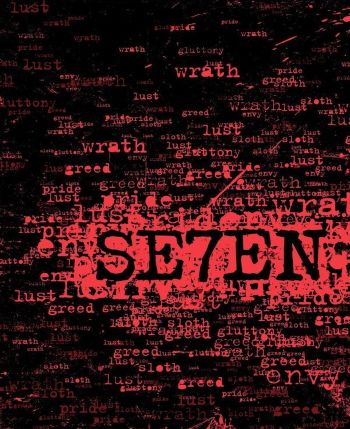

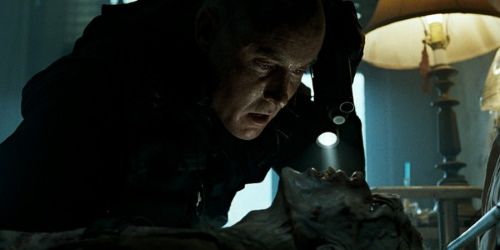
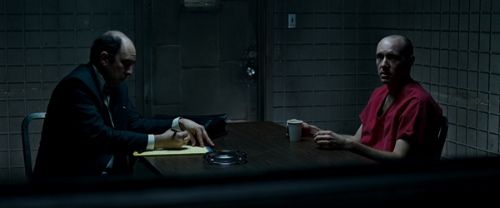
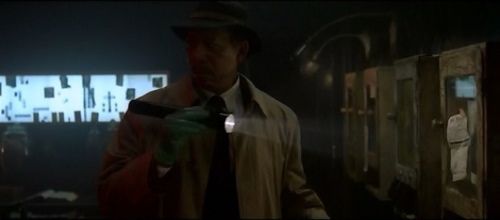

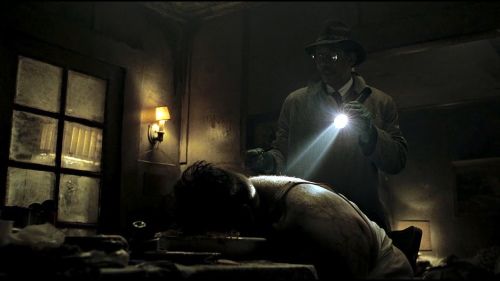
No comments:
Post a Comment